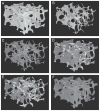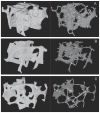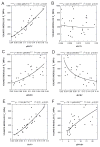Quantification of the roles of trabecular microarchitecture and trabecular type in determining the elastic modulus of human trabecular bone
- PMID: 16995816
- PMCID: PMC3225012
- DOI: 10.1359/jbmr.060716
Quantification of the roles of trabecular microarchitecture and trabecular type in determining the elastic modulus of human trabecular bone
Abstract
The roles of microarchitecture and types of trabeculae in determining elastic modulus of trabecular bone have been studied in microCT images of 29 trabecular bone samples by comparing their Young's moduli calculated by finite element analysis (FEA) with different trabecular type-specific reconstructions. The results suggest that trabecular plates play an essential role in determining elastic properties of trabecular bone.
Introduction: Osteoporosis is an age-related disease characterized by low bone mass and architectural deterioration. Other than bone volume fraction (BV/TV), microarchitecture of bone is also believed to be important in governing mechanical properties of trabecular bone. We quantitatively examined the role of microarchitecture and relative contribution of trabecular types of individual trabecula in determining the elastic property of trabecular bone.
Materials and methods: Twenty-nine human cadaveric trabecular bone samples were scanned at 21-mum resolution using a microCT system. Digital topological analysis (DTA) consisting of skeletonization and classification was combined with a trabecular type-specific reconstruction technique to extract the skeleton and identify topological type of trabeculae of the original trabecular bone image. Four different microCT-based finite element (FE) models were constructed for each specimen: (1) original full voxel; (2) skeletal voxel; (3) rod-reconstructed, preserving rod volume and plate skeleton; and (4) plate-reconstructed, preserving plate volume and rod skeleton. For each model, the elastic moduli were calculated under compression along each of three image-coordinate axis directions. Plate and rod tissue fractions directly measured from DTA-based topological classification were correlated with the elastic moduli computed from full voxel model.
Results: The elastic moduli of skeleton models were significantly correlated with those of full voxel models along all three coordinate axes (r(2) = 0.38 approximately 0.53). The rod-reconstructed model contained 21.3% of original bone mass and restored 1.5% of elastic moduli, whereas the plate-reconstructed model contained 90.3% of bone mass and restored 53.2% of elastic moduli. Plate tissue fraction showed a significantly positive correlation (r(2) = 0.49) with elastic modulus by a power law, whereas rod tissue fraction showed a significantly negative correlation (r(2) = 0.42).
Conclusions: These results quantitatively show that the microarchitecture alone affects elastic moduli of trabecular bone and trabecular plates make a far greater contribution than rods to the bone's elastic behavior.
Conflict of interest statement
The authors state that they have no conflicts of interest.
Figures





Similar articles
-
Complete volumetric decomposition of individual trabecular plates and rods and its morphological correlations with anisotropic elastic moduli in human trabecular bone.J Bone Miner Res. 2008 Feb;23(2):223-35. doi: 10.1359/jbmr.071009. J Bone Miner Res. 2008. PMID: 17907921 Free PMC article.
-
Trabecular plates and rods determine elastic modulus and yield strength of human trabecular bone.Bone. 2015 Mar;72:71-80. doi: 10.1016/j.bone.2014.11.006. Epub 2014 Nov 15. Bone. 2015. PMID: 25460571 Free PMC article.
-
Micromechanical analyses of vertebral trabecular bone based on individual trabeculae segmentation of plates and rods.J Biomech. 2009 Feb 9;42(3):249-56. doi: 10.1016/j.jbiomech.2008.10.035. Epub 2008 Dec 20. J Biomech. 2009. PMID: 19101672 Free PMC article.
-
The quality of trabecular bone evaluated with micro-computed tomography, FEA and mechanical testing.Stud Health Technol Inform. 1997;40:97-112. Stud Health Technol Inform. 1997. PMID: 10168885 Review.
-
Analysis of Biomechanical Characteristics of Bone Tissues Using a Bayesian Neural Network: A Narrative Review.J Funct Biomater. 2025 May 8;16(5):168. doi: 10.3390/jfb16050168. J Funct Biomater. 2025. PMID: 40422833 Free PMC article. Review.
Cited by
-
FSH, Bone Mass, Body Fat, and Biological Aging.Endocrinology. 2018 Oct 1;159(10):3503-3514. doi: 10.1210/en.2018-00601. Endocrinology. 2018. PMID: 30085049 Free PMC article.
-
Chinese Women in Both the United States and Hong Kong Have Cortical Microstructural Advantages and More Trabecular Plates Compared With White Women.JBMR Plus. 2018 Nov 5;3(4):e10083. doi: 10.1002/jbm4.10083. eCollection 2019 Apr. JBMR Plus. 2018. PMID: 31044182 Free PMC article.
-
Dependence of mechanical properties of trabecular bone on plate-rod microstructure determined by individual trabecula segmentation (ITS).J Biomech. 2014 Feb 7;47(3):702-8. doi: 10.1016/j.jbiomech.2013.11.039. Epub 2013 Dec 1. J Biomech. 2014. PMID: 24360196 Free PMC article.
-
Lower peak bone mass and abnormal trabecular and cortical microarchitecture in young men infected with HIV early in life.AIDS. 2014 Jan 28;28(3):345-53. doi: 10.1097/QAD.0000000000000070. AIDS. 2014. PMID: 24072196 Free PMC article.
-
Vertebral body bone strength: the contribution of individual trabecular element morphology.Osteoporos Int. 2012 Jul;23(7):1957-65. doi: 10.1007/s00198-011-1832-6. Epub 2011 Nov 16. Osteoporos Int. 2012. PMID: 22086309
References
-
- . Concensus Development Conference: Prophylaxis and treatment of osteoporosis. Osteoporos Int. 1991;1:114–117. - PubMed
-
- Hansson TH, Roos B, Nachemson A. The bone mineral content and ultimate compressive strength of lumbar vertebrae. Spine. 1980;5:46–54. - PubMed
-
- McBroom RJ, Hayes WC, Edwards WT, Goldberg RP, White AAI. Prediction of vertebral body compressive fracture using quantitative tomography. J Bone Joint Surg Am. 1985;67:1206–1214. - PubMed
-
- Mosekilde L. Normal vertebral body size and compressive strength: Relations to age and to vertebral and iliac trabecular bone compressive strength. Bone. 1986;7:207–212. - PubMed
-
- Silva MJ, Keaveny TM, Hayes WC. Load sharing between the shell and centrum in the lumbar vertebral body. Spine. 1997;22:140–150. - PubMed
Publication types
MeSH terms
Grants and funding
LinkOut - more resources
Full Text Sources
Other Literature Sources

